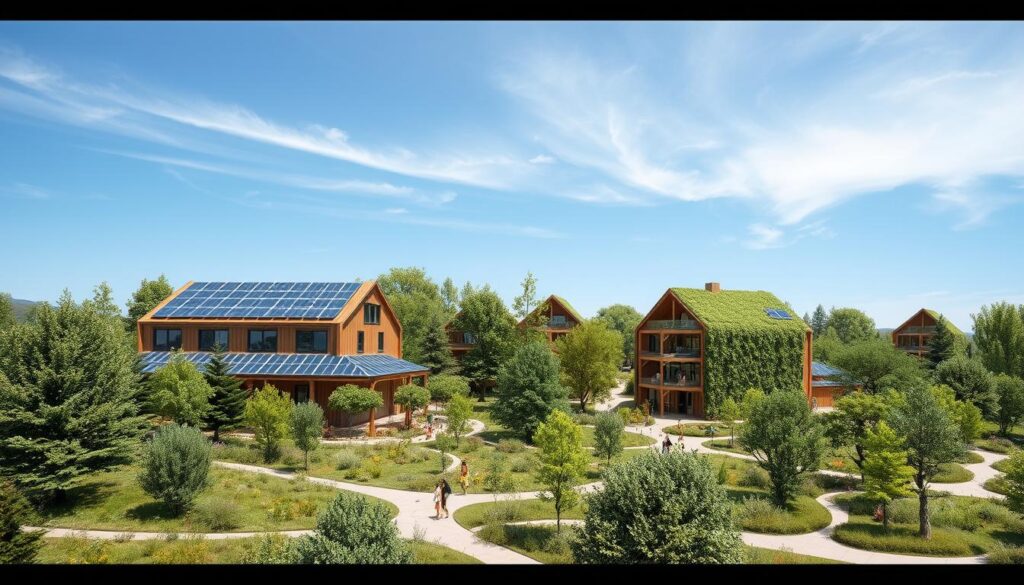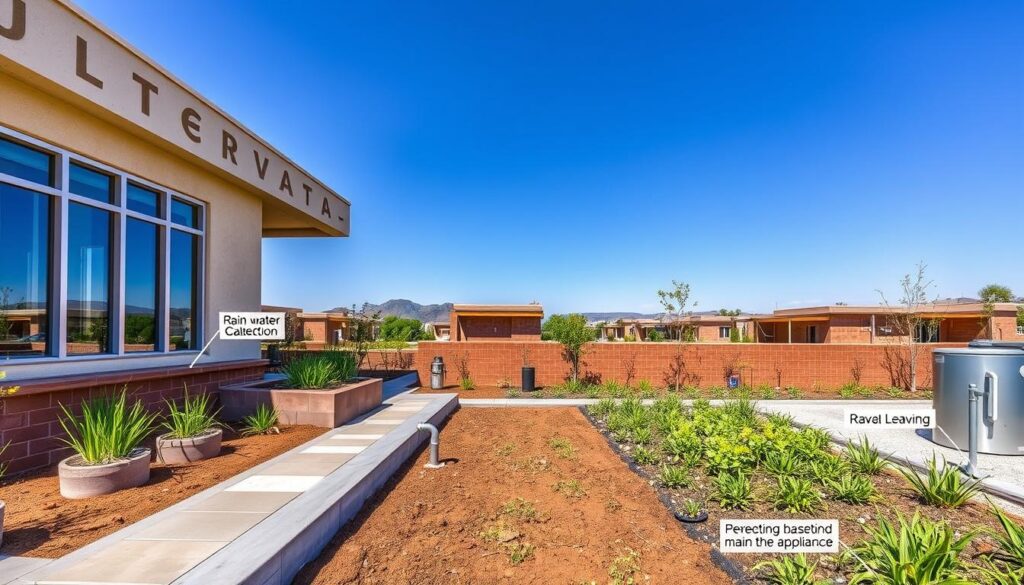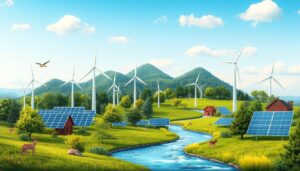Thinking about our future, I see the need for sustainability. Construction and buildings are responsible for about 40% of global emissions. This shows that every building we make affects the planet.
Learning about sustainable building is crucial. It helps us reduce our impact on the environment. We can make a better world for the next generations by using green construction methods. We focus on saving energy, choosing eco-friendly materials, and reducing waste.
Together, we can work towards a greener future. It’s a shared goal that we all can strive for.
Key Takeaways
- Construction accounts for 40% of global emissions and 34% of energy consumption.
- Green buildings emit 34% less carbon than traditional buildings.
- Investment in energy-efficient buildings needs to double by 2030 to achieve net-zero emissions by 2050.
- Green design can reduce building water use by over 30%.
- Materials such as concrete, steel, and aluminum contribute significantly to global emissions.
- Collaboration among architects, engineers, and contractors is essential for successful sustainable projects.
Understanding Sustainable Building Practices
Sustainable building practices are key to making our environment better. They focus on saving energy, conserving water, and using green materials. For example, the 2005 Energy Policy Act requires federal buildings to use 30 percent less energy than the ASHRAE 90.1 standards.
This not only meets the rules but also saves money in the long run. It cuts down on energy and water costs.
In my study of sustainable architecture, I learned how important lifecycle assessments (LCA) are. They measure a building’s environmental impact from start to finish. This helps find ways to make buildings better for the planet.
Sustainable architecture is more than a trend. Fighting climate change and creating healthier places to live is a must.
As more people want sustainable buildings, it’s clear these methods have big benefits. Buildings that use sustainable design are worth more and attract customers who care about the environment. This approach improves our surroundings and community health, leading to a better future.
| Key Principles of Sustainable Building | Benefits |
|---|---|
| Energy Efficiency | Lower operational costs and reduced energy consumption |
| Water Conservation | Decreased reliance on municipal water sources |
| Use of Sustainable Materials | Minimized environmental footprint and support for local economies |
| Waste Reduction | Less landfill impact and encouragement of recycling initiatives |
By using these principles in building, we meet current rules and set a sustainable path for the future. Adopting green building practices today means a healthier planet and stronger communities for tomorrow.
Why Green Construction Matters

The need for green construction is clear as we face global climate challenges. Buildings are responsible for nearly 40 percent of energy-related carbon dioxide emissions. This makes sustainable building practices crucial. The construction industry uses about one-third of the world’s total energy.
Green buildings are good for the environment and society. LEED-certified buildings use 34 percent less CO2 and 25 percent less energy than regular buildings. This big cut in energy use helps fight climate change by lowering our carbon footprint.
Green construction has many benefits. Properties built sustainably have higher values and lower maintenance costs. Green buildings have 20 percent lower maintenance costs than traditional ones. Many developers plan to use green practices in future projects.
Green buildings also improve the health of those inside. Research shows nearly one-third of people suffer health issues from bad building conditions. Eco-friendly construction methods can cut down on sick days and create healthier spaces. This shows how important sustainability is for our well-being and the planet.
Key Benefits of Sustainable Architecture
Choosing sustainable architecture brings many benefits for both businesses and people. One big plus is the cost savings from green construction. This can lead to lower costs for upkeep and operation. For example, green buildings often have maintenance costs that are about 20% less than regular buildings.
Also, going green helps improve public health. People living or working in green buildings feel better. This is because of the eco-friendly materials used. These materials cut down on health risks and make places more enjoyable to be in.
Sustainable architecture also saves resources like water and energy. Green buildings use less water, thanks to special fixtures. In the U.S., buildings use almost 40 percent of energy. Sustainable designs can reduce this, helping us use less fossil fuels.
Green building retrofits can also save money, with costs dropping by almost 10% in just one year. The benefits of sustainable design principles go beyond saving money. They also help the environment. For example, LEED-certified buildings can cut CO2 emissions by 34% compared to non-certified ones.
In the end, the advantages of eco-friendly building practices lead to a greener future and lower costs. As more people and companies see these benefits, the move towards green construction grows. It’s becoming a key part of modern architecture and community growth.
Sustainable Building Practices

Sustainable building practices are key to reducing environmental harm, especially in construction. The built environmentally responsible construction for nearly half of global carbon emissions. Using eco-friendly materials and designs can greatly reduce emissions, making buildings more efficient and healthy.
Reducing Carbon Emissions
Renewable energy systems are a big step towards sustainability. Solar panels, now more affordable, help buildings generate their own energy. This lowers their carbon footprint.
Passive solar design cuts down on the need for heating and cooling. It saves a lot of energy. Using natural ventilation and sunlight also boosts energy efficiency and reduces waste.
Installing energy-efficient windows and doors is another smart move. It helps prevent energy loss, which is crucial for sustainable buildings.
Long-term Cost Savings
Green building offers big economic benefits. It leads to long-term savings on utility bills. This is a big win for the environment and the wallet.
High-efficiency HVAC systems use less energy and cut down on electricity costs. They also improve air quality inside. Planning for waste reduction and resource conservation can save money too.
Properties built with sustainability in mind often have higher values. This shows the economic benefits of these practices over time.
| Practice | Impact on Carbon Emissions | Long-term Economic Benefits |
|---|---|---|
| Passive Solar Design | Minimized need for artificial heating | Lower energy costs |
| Energy-efficient Windows | Reduced energy loss | Enhanced property value |
| Renewable Energy Systems | Lowered dependence on fossil fuels | Long-term savings on utility bills |
| High-efficiency HVAC Systems | Decreased carbon emissions | Lower operating costs |
Green Building Materials and Resources
Exploring green building materials shows us how to build sustainably. Using recycled materials is key to lessening environmental harm from old building ways. Recycling helps avoid waste, saves resources, and cuts energy use, helping our planet.
Utilizing Recycled Materials
Recycled materials like reclaimed wood and plastics are vital for green buildings. They cut down on waste and need for new stuff. Benefits include:
- Less energy use from making less.
- Less carbon emissions from making new stuff.
- Unique looks from old, rich materials.
Innovative Eco-Friendly Materials
New eco-friendly materials are changing building. Things like cross-laminated timber and hempcrete are becoming popular. They offer:
- Better energy saving with better insulation.
- Longer life and less upkeep than old materials.
- Less carbon from using sustainable sources.
Energy-Efficient Buildings: A Necessity

Energy-efficient buildings are a key change in building design for a greener future. Looking at energy use in old buildings shows how much we can save. Buildings in the U.S. use about 39% of all energy, making it crucial to cut down.
The Department of Energy says buildings use 74% of all electricity yearly. This fact highlights the urgent need for buildings that use less energy.
Energy Consumption Statistics
Learning about energy use helps us build better, greener buildings. Old buildings often waste a lot of energy because of bad insulation and old heating systems. This leads to high energy bills and more pollution.
But, new energy-efficient buildings use smart designs like better insulation and windows. These designs save energy and make buildings more comfortable for people inside.
Investment in Energy Efficiency
Putting money into making buildings energy-efficient is key for a sustainable future. Even though these buildings might cost a bit more upfront, they save money on energy in the long run. This makes it worth it for investors.
As the green building world grows, using solar panels and wind turbines is becoming more common. This supports the move towards building in a way that’s good for the planet.
To really get into energy-efficient buildings, we need to keep innovating and investing. I see that making buildings sustainable is not just a trend. It’s something we must do for the future.
Water Conservation Techniques in Construction

Water conservation is key in construction to use water wisely during building projects. The construction world uses a lot of water, with buildings needing up to 350 liters for just one square meter of wall. This means we need new ways to save water, cutting down on use and helping the planet.
Impact on Water Usage
Using smart water-saving methods can greatly reduce water use in building projects. Many projects now use rainwater harvesting systems, which capture and store rainwater for different uses. Greywater recycling systems also help, by reusing water from sinks and showers for non-drinking purposes.
Technologies for Water Efficiency
New technologies have changed the way we build, making water use better. Low-flow plumbing is now common, saving a lot of water. Smart irrigation systems also use water more efficiently than old methods. Drip irrigation systems are great for saving water in landscaping too.
Here’s a look at how different methods save water in construction:
| Technique | Water Conservation Percentage | Benefits |
|---|---|---|
| Rainwater Harvesting Systems | Up to 40% | Reduces need for city water |
| Greywater Recycling Systems | 30-50% | Lessens need for fresh water |
| Low-Flow Plumbing Fixtures | 20-30% | Saves water in buildings |
| Smart Irrigation Systems | 25-40% | Makes water use better |
| Drip Irrigation Systems | Up to 50% | Uses less water than old systems |
| Permeable Paving | Variable | Helps recharge groundwater |
By using these methods, the construction world saves water and helps the environment. Learning about and using these water-saving practices is crucial for future green building projects.
Implementing Sustainable Design Principles
Using sustainable design in our buildings is key in modern architecture. It makes sure our structures are not just useful but also good for the environment. This means planning buildings that use resources wisely and last a long time.
Some important strategies I use include:
- Orientation for Natural Light: Building in a way that captures sunlight can cut down on the need for artificial light. This leads to less energy use.
- Sustainable Ventilation Systems: Good ventilation systems improve air quality inside. They also use less energy for heating and cooling.
- Integration of Renewable Energy Sources: Adding solar panels or wind turbines can make a building energy-independent.
These green building strategies are crucial for saving energy and reducing harm to the environment. For instance, green buildings aim to use at least 30% less energy than the ASHRAE 90.1 standard. This goal fits with federal laws like the Energy Independence and Security Act and Executive Order 14057. They aim for new buildings to have zero emissions by 2030.
By focusing on sustainable design, we take a complete approach. It considers the environment, society, and economy. This way, we build structures that last and protect our planet for the future.
Barriers to Adopting Green Construction Methods
Green construction offers many benefits, but there are still big hurdles. One major issue is the cost. Builders think eco-friendly materials and tech cost too much. This makes them hesitant to use these methods.
But, green buildings actually use 35-40% less energy than regular ones. They can also save up to 30% in operational costs. Showing the long-term savings can help change these views.
- Educating people about green building’s benefits can raise awareness.
- Sharing success stories and local projects shows eco-friendly methods work.
- Government incentives can make green building more accepted and used.
By tackling cost concerns, the construction world can move towards sustainability. Knowing these barriers helps plan and find solutions. This leads to a healthier, greener future. When people understand the benefits, they’re more likely to join in, helping the environment.
Future Trends in Eco-Friendly Construction
Looking ahead, I’m excited about the new trends in green building. These trends are driven by cutting-edge technologies that make buildings more efficient and kinder to the planet. Bamboo, for example, is becoming more popular because it grows fast and can be used in many ways.
Recycled steel is also gaining traction. It’s great for the environment because it cuts down on carbon emissions. Plus, it’s strong and lasts a long time. Rammed earth walls are another trend, using soil and organic materials to keep buildings cool.
Green roofs are becoming a big deal, too. They help clean the air and keep buildings warm. Solar and wind power are changing how we light and heat our homes, making them more self-sufficient.
With financial help from governments, I think we’ll see more green building materials. We’ll see more focus on using less waste and finding better ways to transport materials. Cities will also need to be more adaptable to climate change, with better infrastructure.
The sustainable finance market is expected to grow a lot, from $4.5 billion in 2022 to $29 billion by 2032. This shows how serious people are about building in a way that’s good for the planet. With these new technologies and trends, I’m optimistic about the future of construction.
Conclusion
Looking back, the importance of green construction is huge. Buildings use a lot of energy, so using sustainable materials can help the planet. It also makes buildings better for people who live or work there.
More people now care about how businesses affect the environment. Companies that use green building ideas are not just doing the right thing. They also get ahead of their competitors.
Places like The Bullitt Center and The Tree House show us what’s possible. They use new materials and methods to make buildings that save energy. These buildings attract people who care about the planet.
In the end, we all need to work together for a greener future. This means everyone, from leaders to builders to consumers, has to make choices that help the environment. By doing this, we can make a big difference for our planet and communities.
FAQ
What are sustainable building practices?
Sustainable building practices aim to build in an eco-friendly way. They focus on using less energy, choosing green materials, and cutting down on waste.
Why is green construction important?
Green construction is key in fighting climate change. The building sector is a big polluter. Using green methods helps reduce harm to the environment and makes homes healthier.
What are the benefits of sustainable architecture?
Sustainable architecture saves money and uses less energy. It also makes homes healthier. For example, green buildings can have 20% lower upkeep costs and cut carbon emissions by 34%.
How can I reduce carbon emissions in my building project?
To cut carbon emissions, use green materials and design for energy efficiency. Lifecycle assessments help find ways to lessen your building’s environmental footprint over time.
What types of materials are considered eco-friendly in construction?
Eco-friendly materials include recycled items, cross-laminated timber, and hempcrete. These need less energy to make and help absorb carbon.
Why is water conservation important in construction?
Saving water in construction is crucial. Buildings use a lot of water during building. Using low-flow fixtures and collecting rainwater can greatly reduce water use.
How do sustainable design principles impact building efficiency?
Sustainable design makes buildings work well and use resources wisely. Using natural light and renewable energy lowers environmental harm a lot.
What are common barriers to adopting green construction methods?
A big barrier is thinking green building costs too much upfront. But, it often saves money in the long run.
What future trends should I look for in eco-friendly construction?
Look for smart building tech that saves resources and energy. Also, more green materials and methods are becoming cheaper and easier to use.
Source Links
- https://www.ecowatch.com/green-building-construction-facts-ecowatch.html
- https://seedsacademy.co/course/24/green_buildings_intro
- https://www.gsa.gov/real-estate/design-and-construction/sustainability/sustainable-design
- https://www.pathlightpro.com/7-sustainable-building-best-practices-for-builders/
- https://www.cornerstoneprojects.co.uk/blog/a-guide-to-sustainable-building-practices/
- https://www.usgbc.org/press/benefits-of-green-building
- https://www.pnnl.gov/explainer-articles/green-buildings
- https://newschoolarch.edu/10-benefits-of-green-building/
- https://colitetech.com/blog/the-benefits-of-sustainable-buildings/
- https://www.rowlandbroughton.com/guide-to-sustainable-building-design/
- https://www.foxblocks.com/blog/green-building-techniques
- https://www.linkedin.com/pulse/sustainable-building-practices-paving-way-greener-future-cameron-wick-k7nvc
- https://green.org/2024/01/30/sustainability-and-green-building-practices/
- https://www.alternative-energy-tutorials.com/energy-articles/green-building-materials.html
- https://cove.tools/blog/importance-of-green-building-materials-revgen
- https://sixfab.com/blog/green-buildings/
- https://www.forakergroup.org/predevelopment/resources/energy-efficient-buildings/
- https://www.nps.gov/subjects/taxincentives/energy-efficiency-sustainability-green.htm
- https://theoffsiteguide.com/articles/9-innovative-water-conservation-techniques-in-modern-offsite-construction-projects
- https://www.greenlivingblog.org.uk/best-water-management-practices-for-sustainable-construction/
- https://www.wbdg.org/design-objectives/sustainable/protect-conserve-water
- https://cove.tools/blog/what-is-sustainable-construction
- https://www.wbdg.org/design-objectives/sustainable
- https://budlong.com/5-principles-of-sustainable-design-construction/
- https://www.mdpi.com/2071-1050/16/13/5374
- https://www.emerald.com/insight/content/doi/10.1108/FEBE-07-2022-0029/full/html
- https://quantbuild.co.ke/barriers-to-green-building/
- https://constructive-voices.com/the-future-of-sustainable-construction-predictions-and-technological-trends/
- https://blog.bluebeam.com/key-trends-in-future-green-building/
- https://resetrenovationpartners.com/sustainable-building-practices-how-to-construct-with-the-future-in-mind/
- https://www.mataverdedecking.com/blog/building-a-better-world-how-green-building-materials-benefit-the-environment




